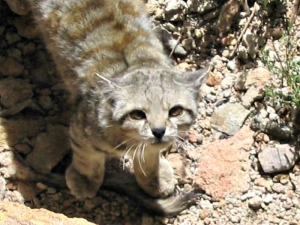Wild cats are in danger of disappearing all over the world. Habitat loss, persecution, poaching, illegal fur, food and pet trades, increased roads and other human interference in their habitats are taking their toll. So how do scientists and conservationists save wild cats?
The first step is to learn about their lives in the native habitat. Where are the cats located? What kind of habitat do they need? What do they eat? How large is the population? These and many other questions must be answered before suitable areas can be set aside and conservation plans put in motion.
Your donations help field researchers purchase radio collars, cameras and other equipment to study the small wild cats. Join our growing list of small wild cat heroes. Please donate today.
100% of donations received go directly to wild cats
One species that has been helped through research made possible by your support is the Andean Cat.
Andean Cats Leopardus jacobita are one of the most beautiful of all wild cats. The fur is mainly ash grey with brown-yellowish blotches that are distributed as vertical lines at both sides of the body, giving the appearance of continuous stripes. Extremely thick, plush fur of silvery grey is very fine and soft, up to 5 cm long on the back, and the underside is pale with dark spots. Prominent dark grey bars also run across the chest and forelegs. The backs of the large, rounded ears are dark grey, and the nose is black. Learn more


